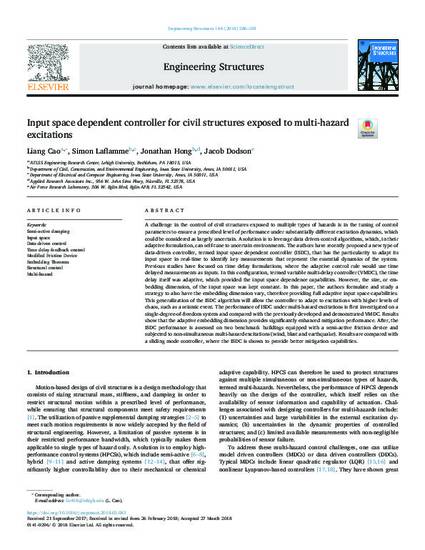
A challenge in the control of civil structures exposed to multiple types of hazards is in the tuning of control parameters to ensure a prescribed level of performance under substantially different excitation dynamics, which could be considered as largely uncertain. A solution is to leverage data driven control algorithms, which, in their adaptive formulation, can self-tune to uncertain environments. The authors have recently proposed a new type of data-driven controller, termed input space dependent controller (ISDC), that has the particularity to adapt its input space in real-time to identify key measurements that represent the essential dynamics of the system. Previous studies have focused on time delay formulations, where the adaptive control rule would use time delayed measurements as inputs. In this configuration, termed variable multi-delay controller (VMDC), the time delay itself was adaptive, which provided the input space dependence capabilities. However, the size, or embedding dimension, of the input space was kept constant. In this paper, the authors formulate and study a strategy to also have the embedding dimension vary, therefore providing full adaptive input space capabilities. This generalization of the ISDC algorithm will allow the controller to adapt to excitations with higher levels of chaos, such as a seismic event. The performance of ISDC under multi-hazard excitations is first investigated on a single-degree-of-freedom system and compared with the previously developed and demonstrated VMDC. Results show that the adaptive embedding dimension provides significantly enhanced mitigation performance. After, the ISDC performance is assessed on two benchmark buildings equipped with a semi-active friction device and subjected to non-simultaneous multi-hazard excitations (wind, blast and earthquake). Results are compared with a sliding mode controller, where the ISDC is shown to provide better mitigation capabilities.
Available at: http://works.bepress.com/simon_laflamme/93/

This article is published as Cao, Liang, Simon Laflamme, Jonathan Hong, and Jacob Dodson. "Input space dependent controller for civil structures exposed to multi-hazard excitations." Engineering Structures 166 (2018): 286-301. DOI: 10.1016/j.engstruct.2018.03.083. Posted with permission.